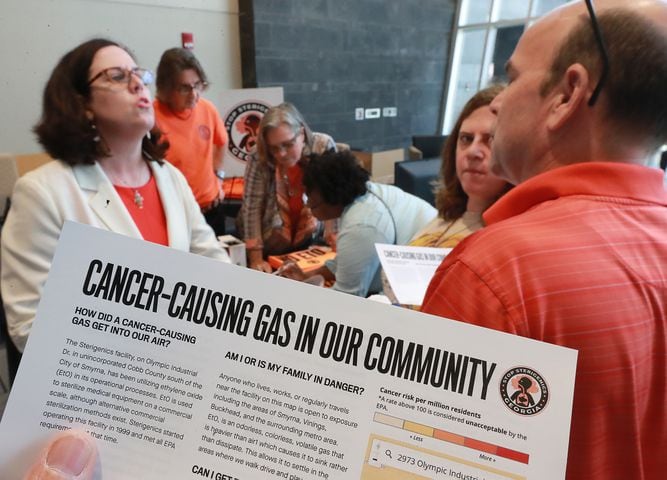Residents of Cobb and Fulton counties on Monday said they want state and federal environmental agencies to do more to ensure the safety of the air they breathe at a town hall meeting about a Smyrna plant and emissions of a carcinogenic gas known as ethylene oxide.
Community groups have been outraged since July when a media report highlighted a 2018 U.S. Environmental Protection Agency study that warned of potential increased long-term risk of cancer in census tracts near the Sterigenics facility in Smyrna. It also found potential higher long-term cancer risks near a similar sterilization facility in Covington that also uses ethylene oxide.
>> Two Dem state lawmakers call for Sterigenics closure
On Monday, the EPA and state authorities held the town hall with panels about the risk of ethylene oxide and the steps regulators are taking to curb emissions at the Sterigenics plant.
They urged calm to the crowd of well over 1,000 inside the Cobb County Civic Center, and said the 2018 report showed that more study of ethylene oxide emissions is needed.
Residents held signs saying “No ETO,” an acronym for ethylene oxide, and many in the crowd sported orange shirts reading “Stop Sterigenics.”
Some booed as speakers from state and federal agencies tried to assure residents that working with the company is the quickest way to reduce emissions and ensure compliance.
VIDEO: Previous coverage of this issue
Albert Luker and Mindy Rolnick made the trip from the Smyrna area to the civic center in Marietta to get answers. Luker, who worked at a facility less than half a mile from Sterigenics from 2014 to 2017, was diagnosed with cancer in his sinuses in January. Luker stumbled across the WebMD and Georgia Health News report on ethylene oxide a few days before he was scheduled to have surgery on July 25.
“I was shocked,” he said when he read the report. He sent the report to a former co-worker who was also diagnosed with brain cancer.
“How can two people who sat beside each other both get cancer?” Luker asked.
The National Air Toxics Assessment, the EPA report that raised alarms last year about potential cancer risks, is “a high-level screening tool” that flags potential air pollution risks, said Mary Walker, EPA Region 4 Administrator in Atlanta.
The study, released last year but based on 2014 data,
found dozens of census tracts in the U.S. have potential high risks for cancer for people with long-term low level exposure to chemicals such as ethylene oxide, but that those areas require additional study.
Dr. Ken Mitchell, deputy director of the air and radiation division at the EPA Region 4 office in Atlanta, said in an interview with The Atlanta Journal-Constitution before the hearing that modeling in June showed lower levels of cancer risk than the NATA report.
Since 2014, the company has reduced its emissions by about 90 percent, officials said.
The June modeling, based on state modeling of Sterigenics emissions data, did not find cancer risks above the EPA’s thresholds of 100 cases in 1 million individuals in residential areas near the plant.
It did find an elevated risk at businesses in the immediate area near the Sterigenics plant.
Mitchell said state and federal regulators are working with the company to improve emissions controls which should solve the problem.
“This is not a run for the hills situation at the Sterigenics facility and we expect it to become better in short order,” Mitchell said.
The state EPD and Sterigenics entered into a consent order in which the company agreed to extensive improvements to its emissions control systems.
Mitchell also said ethylene oxide has been found to be more pervasive than initially understood. Background levels in testing done around the country has found the gas in unexpected areas or in concentrations that were more than expected with sources that were difficult to pinpoint.
During the two-hour formal presentation, a moderator read questions submitted in advance. One that got a round of applause asked why the public wasn’t informed of the 2018 EPA assessment and learned about it through the media.
“I hear you we should have talked to you long before that. I hear you,” said Karen Hays, chief of the air protection branch of the state EPD. “Our focus, right or wrong, was to take the NATA results and find out what was going on on the ground.”
More testing sought
Cobb and Smyrna officials have announced plans to fund air tests near the Sterigenics facility. On Monday, Atlanta City Council approved legislation to join the Cobb and Smyrna tests. Though the facility is not in Atlanta’s city limits, two council districts are within about a mile of the plant.
“The city wants to ensure that our communities have clean air,” Atlanta Mayor Keisha Lance Bottoms said in a news release. “While there is no evidence our residents have been impacted, we must do our due diligence to ensure the well-being of our families.”
Last week, after mounting pressure, the state Environmental Protection Division announced it too would conduct air tests near the Smyrna plant and the BD facility in Covington.
On Friday, Gov. Brian Kemp said state leaders would meet with executives of Sterigenics and BD this week to ensure the companies “take responsibility, embrace transparency, and work with their communities to build trust.”
“As a parent, I understand why local families are worried,” Kemp said in a video message Friday on Twitter. “The results are confusing, the news coverage is frightening and the public has been left in the dark. This situation is simply unacceptable.”
Ethylene oxide is a colorless and combustible gas used to fumigate some agricultural products, sterilize medical equipment and in the manufacturing process of other chemicals such as antifreeze.
The gas is long been known to be harmful, but in 2016 the EPA reclassified ethylene oxide as a carcinogen. The gas has been linked to breast, lymphoid, leukemia and other types of cancers.
Credit: ccompton@ajc.com
Credit: ccompton@ajc.com
Cobb resident Don McWeaty, who lives near SunTrust Park, said he’s concerned that officials have done little to address what he said is a “known carcinogen.”
“I spend a lot of time outside,” he said. “I’m a bicyclist and I may be riding through it.”
McWeaty said the government and corporations have a track record of either downplaying or dismissing reports that certain products have devastating consequences on human health. He used the tobacco industry’s decades-long denial that its product was linked to cancer as an example.
“We have a long history of being lied to about these things,” he said.
Michael Power, a Smyrna resident and representative of the Georgia Chemistry Council, said ethylene oxide is used to make products such as glass and adhesives. Power said it should be noted that ethylene oxide is a naturally occurring chemical that is produced by human bodies, car emissions, cigarette smoke and tree decay.
“There are natural sources for it,” he said.
A Sterigenics spokesman said the company was not invited to the town hall. In an interview last week, Sterigenics President Phil Macnabb said the company is investing $2.5 million as part of a 12- to 24-week project to enhance its emissions controls system.
The new system will improve emissions that go through its stack but also scrub so-called fugitive emissions that can escape detection.
“Our mission and our company is all around safety,” Macnabb said.
Artemis Tjahjono, who lives in Mableton, said she is worried about exposure to children in schools near the Sterigenics plant and wants to see air testing done within school buildings. Tjahjono, who is expecting her second child, said her 6-year-old son attends St. Benedict’s Episcopal School and takes music classes nearby.
Tjahjono said the voluntary steps the company is taking don’t give her much solace.
“We can’t just take their word that this is going to happen,” she said. “You want to relax during your pregnancy, not fight the system and become an activist.”
What is ethlyene oxide?
Ethlyene oxide is a colorless and combustible gas used to fumigate some agricultural products, sterilize medical equipment and in the production of other industrial chemicals. The gas is a carcinogen that has been linked to breast, lymphoid, leukemia and other types of cancers.
The story so far
In 2016, the EPA determined ethlyene oxide is dangerous at much lower levels than previously thought. Based on its new threshold, in 2018, the EPA flagged several census tracts in Georgia for elevated cancer risks from exposure to ethlyene oxide. But the agency did not alert the public. In July, a report by WebMD and Georgia Health News highlighted the risks in Georgia near plants that use ethylene oxide, which has spurred a public backlash and pledges by local and state agencies to conduct air tests.


















